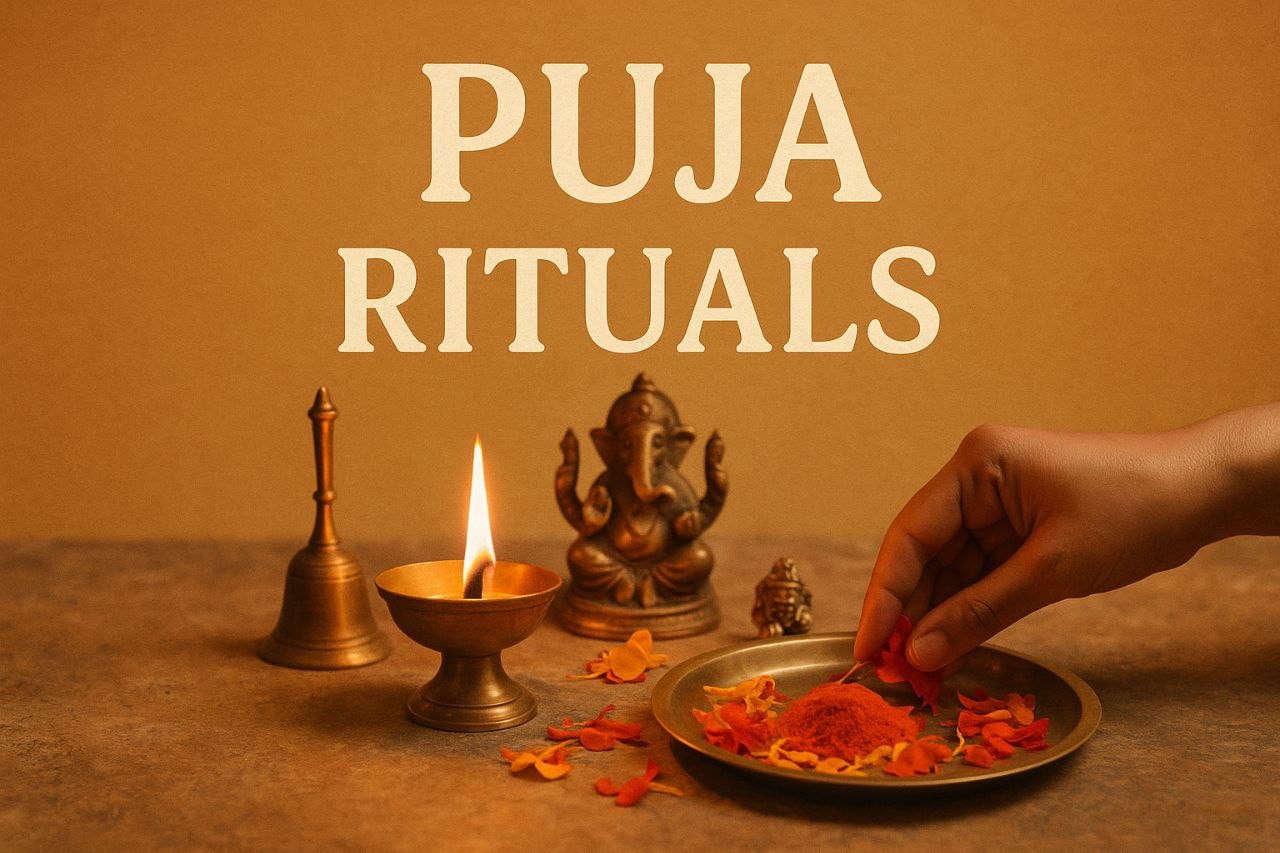Puja Rituals ~ Panchopachāra vs Shodashopachāra

In the sacred tapestry of Sanatan Dharma, puja is more than ritual, it is an intimate dialogue with the divine. Whether performed at home or in a temple, puja becomes a space where the finite meets the infinite. Central to this ritual are two renowned frameworks: Panchopachāra (Five fold offerings) and Shodashopachāra (Sixteen fold offerings).
“Every offering in puja is a note in the symphony of soul and cosmos.” ~ Adarsh Singh
🌺 What Is Puja?
Puja, derived from the Sanskrit pūj (to honor), is the act of honoring, invoking, and connecting with the divine principle. It brings intention, devotion, and presence into tangible expression through offerings.
At its essence, puja is an inner act projected outward: love and reverence shaped into ritual form.
🏵️ Panchopachāra ~ The Five Essential Offers
1. Gandha (fragrance) ~ offering incense
2. Pushpa (flower) ~ offering natural beauty
3. Dīpa (lamp) ~ offering the light of consciousness
4. Naivedya (food) ~ offering sustenance and gratitude
5. Pradakṣina / Namaskāra (circumambulation / salutation) ~ offering respect and surrender
This simple yet potent framework captures the essence of devotion, fragrance, beauty, light, nourishment, and reverence.
“Even five offerings, when given with reverence, become gateways to the infinite.” ~ Adarsh Singh
🔱 Shodashopachāra ~ The Sixteen fold Path of Worship
For those seeking a fuller ceremonial depth, Shodashopachāra expands the ritual into sixteen offerings:
1. Avahana ~ Invocation
2. Asana ~ Seat for the deity
3. Padya ~ Washing feet
4. Arghya ~ Water offering
5. Snāna ~ Bathing
6. Vastra ~ Offering garments
7. Yajnopavita or Abharana ~ Sacred thread or ornaments
8. Gandha ~ Fragrance
9. Pushpa ~ Flowers
10. Dīpa ~ Lamp
11. Dhupa ~ Incense
12. Naivedya ~ Food
13. Tambula ~ Paan or Betel leaf
14. Mantra ~ Chanting
15. Namaskāra ~ Salutations
16. Aarti ~ Flame circling in worship
This complete ritual becomes an immersive offering of service, beauty, and devotion, activating all senses in the act of sacred communion.
🌿 Why Two Paths? Choosing Depth or Simplicity
Panchopachāra is ideal for daily practice, personal devotion, or times when time and resources are limited, but devotion is still pure.
Shodashopachāra is suited for special occasions, temple worship, or when a deeper ceremonial engagement is beautiful and meaningful.
Both paths nourish the soul. One is the elegant bow, the other a ceremonial dance of devotion.
“Whether five petals or sixteen, devotion blooms when offered with integrity.” ~ Adarsh Singh
🧘 Inner Dimensions of Puja
Beyond the external rituals, the true essence of puja lies in:
Intention (Sankalpa) ~ Offering from a clear, devotional heart
Presence (Smṛti) ~ Full attention in every gesture
Sincerity (Bhava) ~ Devotional feeling vibrating through action
Recognition (Darśana) ~ Seeing God in the image and image in souls
These internal elements elevate every external offering into a spiritual bridge.
✨ Making It Meaningful in Modern Life
Even a mini Panchopachāra: flower, lamp, incense, food can become a powerful daily anchor.
Use mindful awareness: breathe consciously, feel the sacred, offer with devotion.
Use intention over scale: a simple puja with devotion often surpasses elaborate ritual without presence.
“A puja shrunk in time but expanded in devotion becomes a timeless portal.” ~ Adarsh Singh
Whether you choose the elegant simplicity of Panchopachāra or the ceremonial richness of Shodashopachāra, Puja remains the sacred art of offering the heart to the divine. It is not merely worship, it is a meeting of two worlds, a dance of love, and a reminder of one’s own divine essence.
“When the heart is the altar, any offering becomes divine.” ~ Adarsh Singh
Wed Jul 23, 2025
